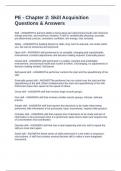PE - Chapter 2: Skill Acquisition
Questions & Answers
Skill - ANSWERThe learned ability to bring about pre-determined results with minimum
energy and time, and maximum certainty. A skill is: aesthetically pleasing, accurate,
pre-determined, precise, consistent, confident, min energy, max certainty.
Ability - ANSWERThe building blocks for skills, they can't be learned, are innate within
you, but can be enhanced and improved.
Open skill - ANSWERA skill performed in an unstable, changing and unpredictable
environment, constant adjustments and decision making required. Externally-paced.
Closed skill - ANSWERA skill performed in a stable, constant and predictable
environment, set technical model and routine to follow. Unchanging, no adjustments or
decision making needed. Self-paced.
Self-paced skill - ANSWERThe performer controls the start and the speed/timing of the
skill.
Externally-paced skill - ANSWERThe performer has no control over the start and the
speed/timing of the skill. Others initiate/control the start and speed/timing of the skill.
Performers base their speed on the speed of others.
Gross skill - ANSWERA skill that involves large muscle groups.
Fine skill - ANSWERA skill that involves smaller muscle groups, intricate, delicate,
precise.
Simple skill - ANSWERA skill that requires few decisions to be made when being
performed, little information to be processed, basic movements, requires little practice.
Complex skill - ANSWERA skill that requires lots of decisions to be made and lots of
information to be processed when it is performed, takes time to learn and requires lots
of concentration and coordination.
Discrete skill - ANSWERA skill that has a clear beginning and end, and to repeat the
skill you must start again.
Serial skill - ANSWERA linked series of skills performed in a set order or sequence,
sub-routines. A skill that contains several discrete skill to make a more integrated
movement.
, Continuous skill - ANSWERA skill that has no clear beginning or end, the end of one
movement is the start of the next.
Low organisation - ANSWERA skill that is easily broken into parts/ sub-routines, eg: lay
up, triple jump, swimming strokes.
High organisation - ANSWERA skill that is difficult/not easily broken into parts/sub-
routines, eg: swimming dive, hockey dribble, forward roll.
What consider when teaching a skill - ANSWERThe performers stage of learning,
ability, age, experience.
On the situation, time available, facilities.
The level of danger and safety needed to perform the skill.
Motivation and personality of performer.
The size of the group you're teaching.
Positive transfer - ANSWERWhen the learning and performance of one skill helps/aids
the learning and performance of another. Tends to occur when 2 skills have a similar
shape/form. eg: netball and basketball pass, long barrier and wicket keeper in rounders
and cricket.
Negative transfer - ANSWERWhen the learning and performance of one skill
hiders/inhibits the learning and performance of another. Tends to occur when there
might be some familiarity with the environments in which the 2 skills performed, causing
confusion because the actions of the skills are not the same. eg: badminton and tennis
forehand, shot-put and an overarm throw.
Zero transfer - ANSWERWhen the learning and performance of one skill has no impact
on the learning and performance of another. Happens because the 2 skills in question
have no similarities so there is no confusion. eg: swimming arm action and the the foot
placement in rock climbing.
Bilateral transfer - ANSWERWhen learning and performance of one skill is passed
across the body from limb to limb. So the impact of a skill on the left side is the the
same as the impact on the right side. eg: footballers using both feet to shoot, dribbling
with left then right hand, catching and throwing with both hands.
Theory of transfer - ANSWERHow the effect of the learning and performance of one
skill impacts the learning and performance of another.
Whole practice - ANSWERPracticing the skill in its entirety, without breaking it into its
sub-routines, usually can't be broken into sub-routines. Use when: a skill is fast, ballistic,
discrete, highly organised, simple (have to think less so less demands on performer),
feel of task is required, autonomous stage of learning - can cope with demands, elite
performer, links between sub-routines need to be maintained/ performed in specific




